BY HENRY SHEEHAN
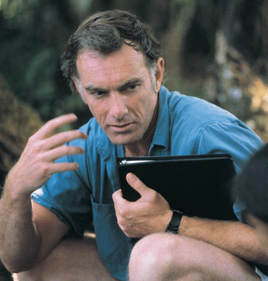 HISTORY LESSON: Polanski's graphic treatment of the
HISTORY LESSON: Polanski's graphic treatment of the
Shakespearean tragedy
burned its way into John Sayles'
brain when he first saw it 35 years ago.At first glance—and probably second glance and maybe even third—Roman Polanski's 1971 The Tragedy of Macbeth doesn't seem a candidate for John Sayles' favorite movie list. Sayles, after all, is one of American cinema's most persistent, socially conscious realists. While the director-writer (and usually editor) has, technically speaking, made period films (Eight Men Out, Matewan, and his brand new Honeydripper), these films at least implicitly refer to the past's direct effects on the present. They certainly don't synch with Polanski's florid adaptation of Shakespeare's saga of murder and ambition in 11th-century Scotland.
"I think it's a great piece of filmmaking," Sayles shrugs when the conundrum is raised. Sayles says the movie had burned itself into his memory since its first engagement more than 35 years ago. And though he hasn't seen it in many years, he claims its particulars are still there in his head.
It sounds like a casual boast, though that would be unusual coming from Sayles, a perennial candidate for the title of most unaffected movie director in the world. If micro-budgets have kept him from duplicating Polanski's complex camera movements and lighting, he has been able to follow Polanski's lead when it comes to dramatic environment. Macbeth does have a series of murders, largely committed in secret and followed by coverups, as do many of Sayles' films—Lone Star, Limbo, City of Hope, even Eight Men Out. Perhaps Sayles, like the characters in Macbeth, is preoccupied with the struggle for power and the cost of keeping the skeletons buried. "To me it's not so much about power as it's about history," he suggests. "Digging up the bones represents that none of us get to start from scratch, even if we don't know our history. If you dig back in history and you dig deep, maybe things weren't the way we've taken for granted."
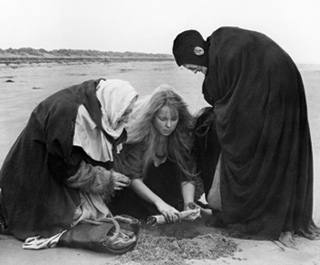 EVILDOERS:The three witches burying a severed arm set the violent
EVILDOERS:The three witches burying a severed arm set the violent
tone of the film. (Credit: Photofest).When we sat down to watch the film, Sayles was visiting Los Angeles to introduce Honeydripper, a musical drama about the blues set in a rural Southern black township, at AFI Fest. Sayles was camped out in a comfortable but cozy room in the Roosevelt Hotel, following a schedule that apparently left little time for sleep or meals. However, a delivery of In-N-Out burgers assuaged acute hunger while he watched the film.
No sooner does Macbeth's first image—a crimson dawn slowly illuminating a muddy, lonely beach—light up the screen then Sayles is enthusing over Polanski's creative responses to a relatively scant budget, a subject any cash-strapped independent director knows something about. "I think he had $4.5 million, which wasn't very much even at the time."
Sayles points out Polanski's use of a wide lens to capture a seaside plain, where a blood-streaked dawn sky gives way to the gray of morning. The weird sisters—the witches whose soothsaying will guide the warrior Macbeth (Jon Finch) to his doom—enter from the sides and bury spell-enhancing objects, including a severed arm, in the sand. Mist from the sea covers their exit, the clash of swords is heard behind the damp, cloudy curtain, and the airy moisture dissipates to reveal the detritus of battle—dead bodies, and triumphant, exhausted soldiers, one of whom uses a mace to finish off a wounded foe.
"All this is going to continue through the rest of the movie: the rain, the violence, the physicality," says Sayles. "As soon as you see the setting and then that arm, you know he's presenting the drama as a violent grind."
Polanski himself has brought most of this violence to the action. As Sayles points out, Polanski doesn't replicate Shakespeare's sense of the supernatural. Rather, he bores in on the psychological component. "That's what Shakespeare brought to drama, the character psychology. And Polanski brings it out even more."
After Macbeth has visited the witches for the first time and heard the prophecy that he'll be king, his friend Banquo (Martin Shaw) asks him where the witches have gone. Macbeth answers, as Shakespeare has him, that the witches have disappeared into vapor. But Polanski has Macbeth looking right at the witches as they descend into a ruin where they cast their spells. "He wants to mystify Banquo, to manipulate him. He sees the witches just walk out of sight, but he wants his friend to think they're supernatural. It makes their predictions more plausible."
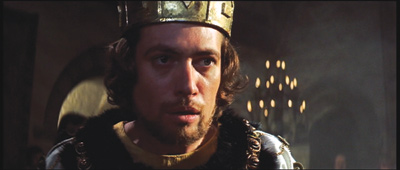
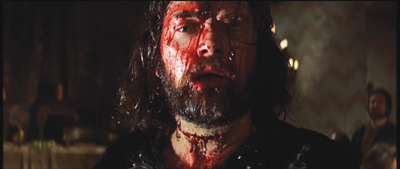 TO THE DEATH: Macbethsees the ghost of his friend Banquo and
TO THE DEATH: Macbethsees the ghost of his friend Banquo and
imagines his gruesome murder. (Credit: Sony Pictures)Sayles' greatest example of Polanski's substitution of psychology for mystery comes at the banquet scene where, in front of his vassals, Macbeth breaks down when he alone sees the ghost of Banquo, whom he's just had murdered. But Polanski evokes paranoia rather than supernatural terror. Macbeth doesn't see Banquo's fatal wounds as they were, but sees them as they were exaggerated by the men who killed him.
"Banquo didn't have 20 mortal bashes on his head, he had one axe in the back," Sayles explains. "It's a nice thing Polanski's doing with Shakespeare, to say this is a figment of Macbeth's imagination; it's what he imagines of the killing. It's different than what Shakespeare would have done. He would have had a guy dressed up and it would really be a ghost. Polanski is indicating that this is this guy's conscience doing this. So Macbeth doesn't see the real ghost—which would have an axe in its back—but he sees what they talked about."
In this scene, as in many others in the movie, Polanski and his cinematographer, Gilbert Taylor, pull off elaborate camera movements whose sinuous grace belie the difficult lighting and focal adjustments that have to accompany them. It's one of the film's features that most enraptures Sayles.
"Very nice movement there. They panned up and then they tracked down the corridor here," Sayles almost coos as Polanski traces the moves of the characters who are about to discover the murdered body of King Duncan.
Does Sayles feel jealous that Polanski, even at what was for him a low budget, had more money to mount these complex movements than Sayles is used to? "No," he answers. "When you can do it, you do it, like in Honeydripper, we made a bar. It's a big deal that I get to do that. You can design it so that you have shots in mind. You put a window there so somebody can leave and then you can follow your character outside through it. Macbeth kind of uses half-real locations, but a lot of it is sets that they built."
In Macbeth—no matter who's doing it—the characters are either getting ready to kill someone, killing someone, or suffering the aftereffects of killing someone. For the latter, Sayles points out, Polanski likes to isolate the distraught character within a relatively large, empty space. But doing a full-on deep focus shot, with a shallow lens and the requisite lighting, isn't always possible or even desirable.
Take for example Lady Macbeth's (Francesca Annis) final scene—final because she's soon going to kill herself. Though she's in a large room with a doctor and nurse, Polanski wants to show her alone. But rather than just push the camera up into her face for an ugly widescreen close-up, Polanski gives her a whole half frame for her head and shoulders and the other half frame to the back of the room and a window.
"For composition, when you want that feeling of space, instead of closing her off you have to have a little light coming in those windows and it gives you all the depth you want," Sayles notes. "It can be way out of focus, but it gives you depth. It's one of the ways to deal with a fairly tight shot in a wide screen."
And, Sayles says, because so many of the castle interiors feature appropriately large fireplaces with effulgent flames, Polanski was able to employ this device virtually whenever he wished, even in transitions. In a scene where Macbeth sends two ruffians on their way to murder Banquo, he turns from a doorway, where he's framed tightly against a sort of vestibule, and walks back into the room proper. Our eyes are drawn immediately to the rear wall where a fire burns in a fireplace and we feel the sudden large emptiness of the king's room. "See, alone," Sayles says in the staccato speech that reflects his intense concentration. "The fire gives size to the room where he's all alone, isolated, paranoid.
"When I worked with the cinematographer Michael Ballhaus [on Baby, It's You and a Bruce Springsteen music video], often he'd put a light way in the background that didn't even necessarily have a function, but what it does is give you depth without having to light too much," he says. "One of the things that you want in any frame is a very black spot and a very white spot. If you get that, it gives you a range so that your eye is comfortable with everything in between. Good cinematographers will find that place to have a little bit of light or some gold or metal with some shine on it, so there's a really high brightness."
Even as he continues munching on his hamburger, Sayles' attention to detail is so extraordinary he notices the humblest of actors: livestock.
"All his life, Macbeth's been a professional soldier; he hasn't worried about politics," he says. And that's reflected in the relative modesty of his castle and even its courtyard. "You see it's all muddy; these pigs are just running around here." But as Macbeth murderously climbs the slippery pole of politics, he moves castles, first as Thane of Cawdor and then as king. "See, the walls are all whitewashed here," in contrast to the previous domiciles' bare walls. "And see in the courtyard, it's dry and [the only animals] are sheep, lambs."
Sayles also appreciates the physicality of burying the bones. There's a lot of chopping, slicing and bashing of body parts in Polanski's movie, and Sayles' engaging analysis is goosed by a boyish enthusiasm whenever the characters pull their swords—heavy, broad and evil-looking—from their scabbards.
So when the blood rises and Macbeth confronts his final foe Macduff (Terence Bayler), Sayles delivers an enthusiastic play-by-play. "The punching and gouging and all this sort of shit," Sayles enthuses. "There goes the crown. Polanski chopped two frames there. Like in a kung-fu movie, if you chop frames you can speed up action that looks too stagey or slow. I love this. Even if you hit, unless you can chop his arm off or something and get that little knife in through his helmet, half the time you can't kill him.
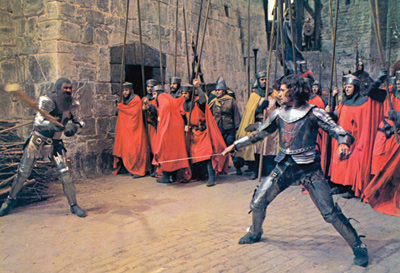 Macbeth vanquishes his last enemy Macduff with a physical rather than a
Macbeth vanquishes his last enemy Macduff with a physical rather than a
swashbucking swordfight. (Credit: Photofest)"Finch is a good swordfighter, he's good at it," Sayles continues. "The other guy's got a hood on, so I think that's a stunt double. But Finch is doing a nice job. It's like a Davy Crockett brawl rather than a Basil Rathbone thing." Finally, as the last drop of blood seeps into the earth and new plots seem to hatch, Sayles sums up his essential pleasure with Polanski's The Tragedy of Macbeth:
"What's the history of Europe? And all those crown heads? It's kind of like the history of the Mafia. As I said, Polanski just made a really physically well-made movie. Staging this classic stuff so that it turned into a movie. Not an easy thing to do."